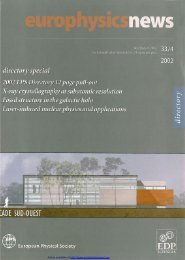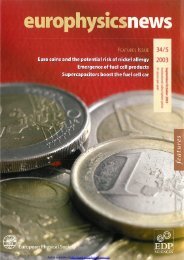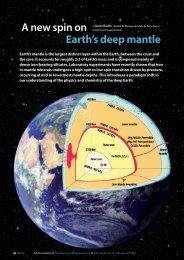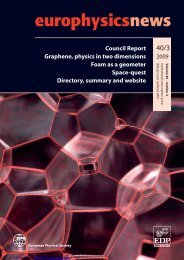Whole issue in PDF - Europhysics News
Whole issue in PDF - Europhysics News
Whole issue in PDF - Europhysics News
You also want an ePaper? Increase the reach of your titles
YUMPU automatically turns print PDFs into web optimized ePapers that Google loves.
FEATURES<br />
I, - Hadron I 300······~rad . ....<br />
IU<br />
••••••<br />
i -- Unknown . ....<br />
......... , ::.~.<br />
---';;.,.<br />
......•..<br />
.......<br />
e-co.093rad<br />
.•..<br />
.....•.<br />
'P;>306~Mevfc<br />
....<br />
'-'<br />
•...<br />
P>3.3~;G.rifc<br />
.............•..<br />
.,' .<br />
..~ .<br />
X;,-~:::::~'\\ ': ~..,<br />
'f"<br />
"<br />
f /~"'\ \.;..................<br />
. .. .....<br />
, 1~l"Qrad •../ J' .......<br />
11 ..................''::l.. '0 •<br />
r- '. .'<br />
--Electron ....... 200l"Q~ad .........,<br />
BOO<br />
jUll<br />
..'<br />
a'.'<br />
."<br />
....<br />
400 ..<br />
..-.'<br />
0<br />
•.•.....<br />
a<br />
'IP •••• "<br />
a<br />
-40<br />
. .<br />
·80<br />
-120 .<br />
.. .<br />
...... . .<br />
... ~.-.<br />
....<br />
........<br />
. .<br />
......<br />
Fig. 2: One of the four observed<br />
tau neutr<strong>in</strong>o charged current<br />
<strong>in</strong>teractions. The k<strong>in</strong>k signature<br />
of the tau decay is clearly visible.<br />
The target is represented at the<br />
bottom:<br />
steel =blue<br />
emulsions = yellow<br />
In this example the tau decays<br />
<strong>in</strong>to an electron. ~<br />
or 800 l1Ill thick plastic base. A target module consisted of -50<br />
steel/emulsion layer pairs to obta<strong>in</strong> a thickness of0.16 <strong>in</strong>teraction<br />
lengths. The bulk type was composed exclusively of emulsion<br />
plates with 350 J.lm thick emulsion layers on either side ofa 90 J.lm<br />
thick plastic base. These modules were 0.13 <strong>in</strong>teraction lengths<br />
thick. The transverse size of all emulsion and steel sheets was<br />
50 cmx 50 cm. Between emulsion modules, 44 planes ofsc<strong>in</strong>tillat<strong>in</strong>g<br />
fibers provided precision track<strong>in</strong>g, and were read out by an<br />
image <strong>in</strong>tensifier system.<br />
The Event Analysis<br />
Neutr<strong>in</strong>o <strong>in</strong>teractions <strong>in</strong> the emulsion target were selected by trigger<br />
hodoscopes <strong>in</strong> the target region. For each accepted event all<br />
electronic detector components were read out. The <strong>in</strong>formation<br />
from the spectrometerand calorimeter was used to select possible<br />
candidate events. All charged particle tracks from these candidate<br />
events were projected back to the exit po<strong>in</strong>t ofthe emulsion target<br />
us<strong>in</strong>g the sc<strong>in</strong>tillat<strong>in</strong>g fiber track<strong>in</strong>g system. The reconstructed<br />
tracks were then used to reconstruct a vertexwith a typical precision<br />
of 1 mm <strong>in</strong> the transverse coord<strong>in</strong>ate and 7 mm <strong>in</strong> the beam<br />
direction. This event selection was used to limit the size of the<br />
search volume <strong>in</strong> the emulsion target. Dur<strong>in</strong>g the run, 4.0 x 10 6<br />
triggers were recorded from 3.54 x 10 17 protons <strong>in</strong>cident on the<br />
tungsten target. After further cuts on the event geometry and<br />
energy a total of898 events were classified as neutr<strong>in</strong>o <strong>in</strong>teraction<br />
candidates. Of the 898 candidates, 698 had a vertex predicted<br />
with<strong>in</strong> the emulsion fiducial volume. Additional requirements on<br />
the event topologyandvertex precision reduced the sample to 499<br />
events. These 499 events were scanned us<strong>in</strong>g a fully automated<br />
emulsion scann<strong>in</strong>g stations, which followed all tracks from the<br />
vertex through the different emulsion sheets. The result of this<br />
scann<strong>in</strong>g is a 3D digitised image of the <strong>in</strong>teraction with a precision<br />
betterthan 1 flII1. A valid vertexwas located for 262 ofthe 499<br />
events.<br />
A method of fully automated scann<strong>in</strong>g has been developed<br />
over the past 20 years by the group ofK. Niwa and his colleagues<br />
europhysics news MARCHIAPRIL 2001<br />
<strong>in</strong> Nagoya, Japan [2,3]. This technique was used <strong>in</strong> the CHORUS<br />
experiment, and most recently allowed the direct observation of<br />
the Vt <strong>in</strong> DONUT. The capacityto analyse a largevolume ofemulsion<br />
will allow the use of massive targets of nuclear emulsion <strong>in</strong><br />
future high-energy experiments.<br />
The Result<br />
Emulsion plates conta<strong>in</strong><strong>in</strong>g located events were rescanned with<strong>in</strong><br />
an adjusted scann<strong>in</strong>g volume centred on the event. After further<br />
alignment 203 events satisfied the criterion ofa track resolutions<br />
better then 0.6 flII1. In these 203 events a detailed decay searchwas<br />
performed,look<strong>in</strong>g for the event topology ofa tau neutr<strong>in</strong>o <strong>in</strong>teraction<br />
- a k<strong>in</strong>k<strong>in</strong> one ofthe primarytracks.<br />
The selection criteria for V't events were established by Monte<br />
Carlo simulation.<br />
After the application of these selection criteria to the sample of<br />
203 events, four events rema<strong>in</strong>ed. This experimental result is consistent<br />
with the number of expected 't events <strong>in</strong> the sample, 4.2<br />
events. The total number ofbackground events is estimated to be<br />
0.34 ± 0.05. Therefore the probability that all four events are a<br />
result ofa background fluctuation is 4 x 10-4.<br />
Figure 2 shows one ofthe four events, the first direct observation<br />
of charged current tau neutr<strong>in</strong>o <strong>in</strong>teractions. These events<br />
confirm the existence of V t as a partner of the tau lepton <strong>in</strong> the<br />
Standard Model ofelectroweak <strong>in</strong>teractions.<br />
For more detailed <strong>in</strong>formation on the event selection procedure<br />
see reference [4].<br />
References<br />
[1) M. L. Ped etal..Phys. Rev. Lett. 3S, 1489 (1975).<br />
[2] S. Aoki et al., Nud. Instr. Meth. BSI, 466 (1990).<br />
[3] T. Nakano, Ph.D. Thesis, Nagoya University (1997).<br />
[4] K. Kodama et al., Observation ofTau Neutr<strong>in</strong>o Interactions, submitted<br />
to Phys. Lett. B.<br />
57










